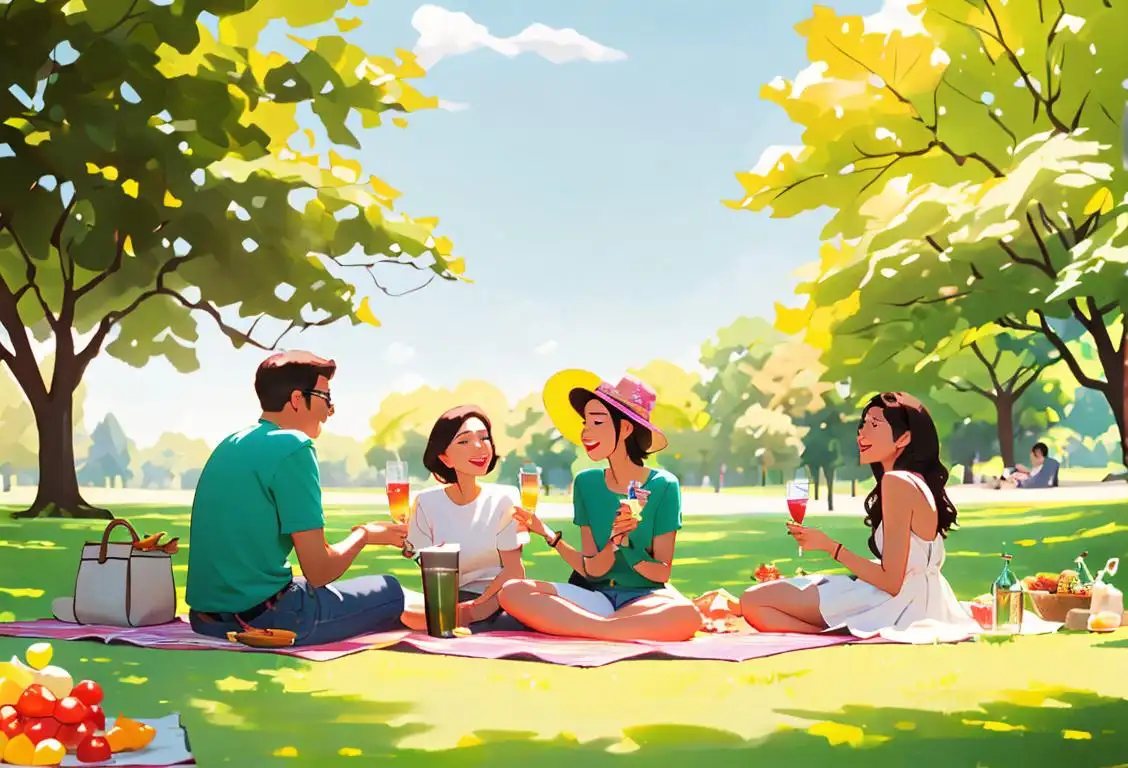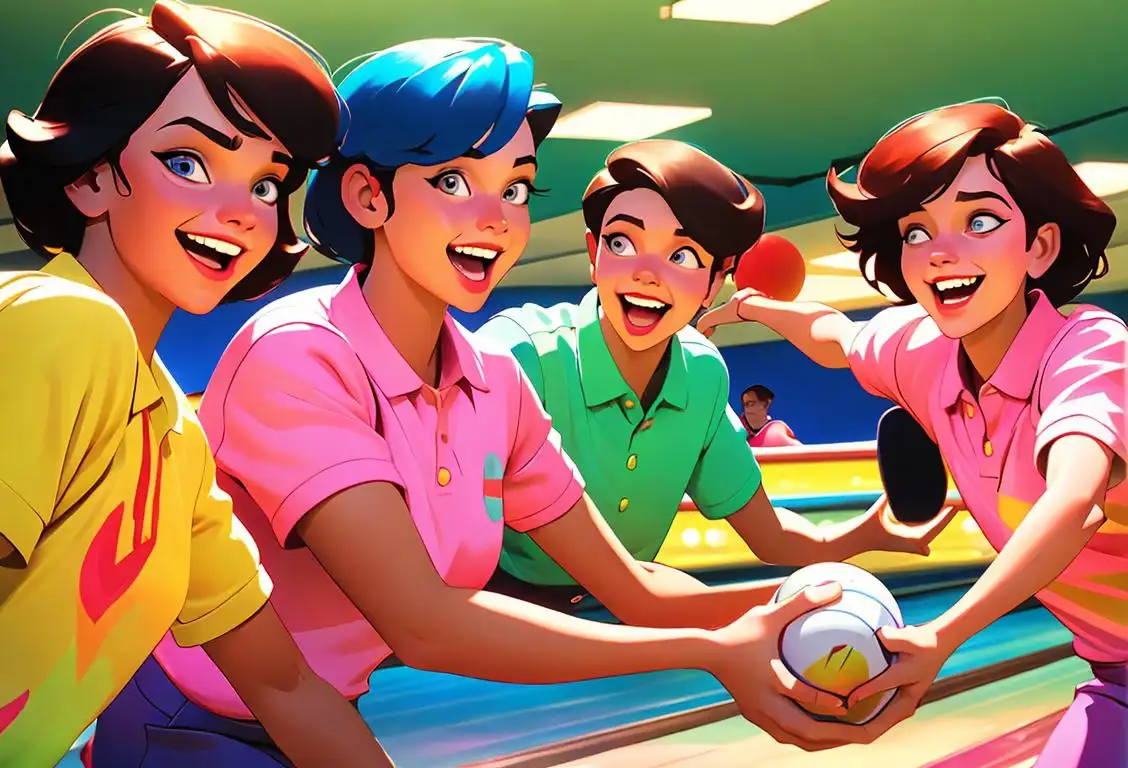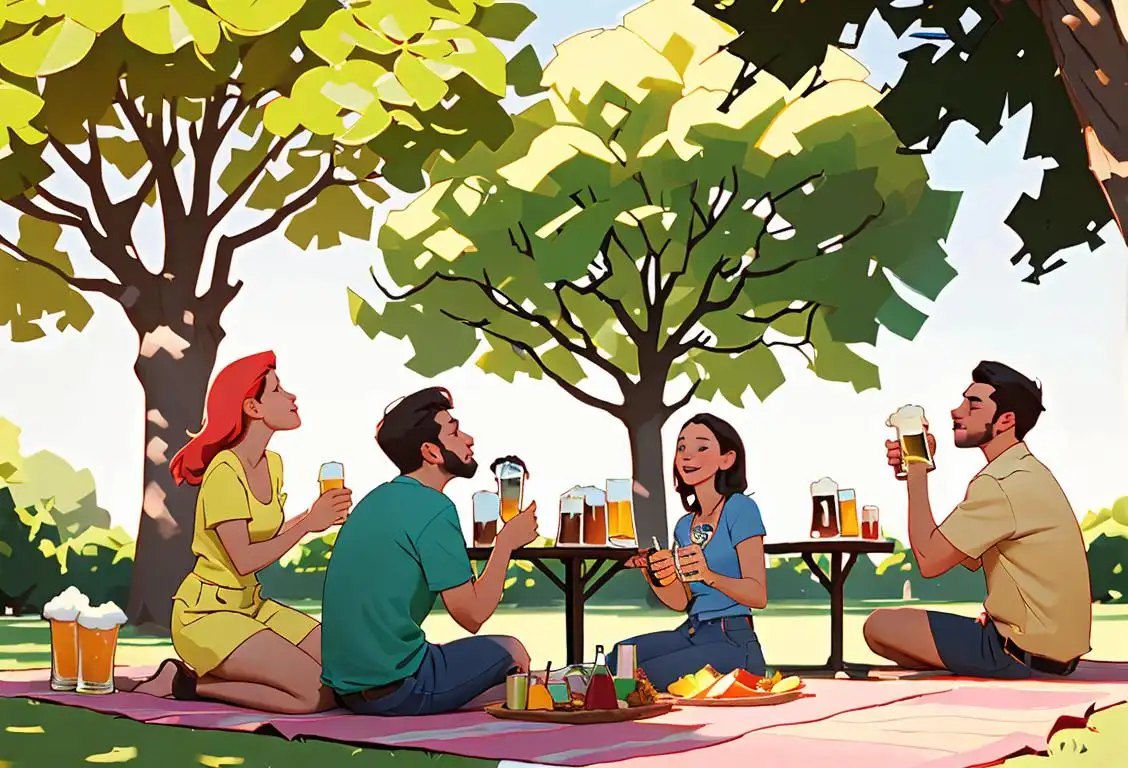National Refreshments Day

Welcome to the wacky world of National Refreshments Day! Prepare your taste buds for a tantalizing trip through the history of our favorite thirst-quenching treats. From fizzy drinks to fruity beverages, we've got it all covered. So sit back, relax, and let's dive into a refreshing adventure!
When is Refreshments Day?
It's national refreshments day on the 23rd July.
The Origins of National Refreshments Day
Have you ever wondered how National Refreshments Day first came to be? Well, it all started back in the halls of the internet, where thirsty netizens sought to celebrate their love for all things hydrating. With the click of a button and the stroke of a keyboard, they united under one virtual umbrella and declared July 23rd as the official day to raise a glass in honor of their favorite refreshments.
Since then, National Refreshments Day has gained popularity, with people from all walks of life coming together to celebrate the joys of staying hydrated. It's a day to appreciate the simple pleasure of sipping on a cold drink on a hot summer's day or cozying up with a warm mug of goodness during the chilly winter months.
A Tribute to Thirst
On National Refreshments Day, there's a beverage for every occasion. Whether you're a fan of classic sodas, iced teas, smoothies, or even fancy craft cocktails, this is the perfect day to savor your favorite drink.
For the sports enthusiasts out there, you can grab a cold sports drink to cool down after a rigorous game. And let's not forget the coffee connoisseurs who rely on their daily dose of caffeine to kickstart their mornings.
But National Refreshments Day isn't just about the drinks themselves; it's also about the memories and moments they create. Think about the times you've shared a toast with friends, enjoyed a romantic coffee date, or simply savored a quiet moment of relaxation with your favorite beverage. These are the moments that this day celebrates.
Did You Know?
Did you know that the world's oldest known recipe for a beverage dates back over 4,000 years? It's true! The recipe, discovered in ancient Mesopotamia (modern-day Iraq), was for a refreshing barley-based drink. Talk about a blast from the past!
History behind the term 'Refreshments'
1650s
Emergence of the term 'refreshments'
The term 'refreshments' originated in the 1650s and was derived from the verb 'refresh,' which means to revive or restore. Initially, 'refreshments' referred to the act of refreshing or restoring oneself, primarily through eating or drinking.
1560
The Emergence of the Term
In the 16th century, the term 'refreshments' first emerged, being used to describe the act of refreshing oneself, usually through the consumption of food and drink. The term became popular in Europe and was commonly associated with breaks during journeys or social gatherings.
1699
Introduction of the term 'refreshments'
The term 'refreshments' was first used in 1699 to refer to food or drinks that provide nourishment, satisfaction, or relief from thirst. The word 'refresh' has Old French origins, coming from the word 'refreschir', which means to cool or revive. As a noun, 'refreshment' refers to the act of refreshing or something that refreshes.
15th century
Early Usage
The term 'refreshments' first appeared in the 15th century, derived from the Middle English word 'refreshen', which meant 'to revive' or 'to renew'. At this time, it was primarily used in relation to the replenishment of energy or strength.
1590
The emergence of the term 'refreshments'
In the year 1590, the term 'refreshments' first appeared in the English language. It was derived from the verb 'refresh,' which means to provide new energy or to revive. Initially, the term 'refreshments' referred to the action of revitalizing oneself through food or drink.
1750
The Emergence of the Term
The term 'refreshments' first appeared in the English language around the year 1750. It emerged as a way to describe the act of refreshing oneself, particularly through the consumption of food and drink. During this time, the term was often associated with providing nourishment and rejuvenation to individuals.
1600
The Origin of 'Refreshment'
The term 'refreshments' can be traced back to the early 17th century. It originated from the verb 'refresh,' which means to renew or restore strength or vitality. The word 'refreshment' was used to describe the action of taking food or drink to revive or invigorate oneself.
1300s
The Origins of 'Refreshments'
During the 1300s, the term 'refreshments' first emerged in the English language. It is derived from the Middle English word 'refreshen', which means to revive or restore. Initially, the term referred to the act of reviving oneself or gaining new energy. It later evolved to encompass food and drinks that provide nourishment and replenishment.
1400
The Emergence of 'Refreshments'
The term 'refreshments' first appeared in the English language during the 15th century. It comes from the Middle English word 'refreshen', which means to revive or invigorate. 'Refreshments' referred to the act of restoring vitality and energy through food and drink.
14th Century
Emergence of 'refreshments'
In the 14th century, the term 'refreshments' started to emerge in the English language. It derived from the Middle English word 'refreshen', meaning to renew or revive. During this time, the term referred to reviving or invigorating oneself by taking food or drink.
19th Century
Rise of Refreshments in Social Gatherings
In the 19th century, the concept of refreshments gained popularity and became an integral part of social gatherings. Whether it was a formal event, a party, or a casual get-together, providing refreshments for guests became a sign of hospitality and good manners. Refreshments were served to alleviate hunger or thirst and to create a convivial atmosphere.
1665
Use of the term during the Great Plague
During the Great Plague in 1665, the term 'refreshments' gained significance as it was used to describe small meals or snacks that were offered to those affected by the epidemic. These refreshments provided vital sustenance to the afflicted and were often distributed by charitable organizations.
17th Century
Evolution of 'Refreshments' in Social Gatherings
In the 17th century, 'refreshments' gained popularity as a term used to describe the snacks and light fare served during social gatherings. These refreshments were offered to guests as a way to provide sustenance and enhance their enjoyment of the event. The term became synonymous with the notion of hospitality and became an integral part of various cultural traditions.
17th Century
Introduction of 'refreshment' establishments
In the 17th century, 'refreshment' establishments began to appear, providing people with a place to enjoy food and drinks. These establishments were often taverns or inns that served as meeting places to socialize, eat, and replenish one's energy.
18th century
Expanding meaning to include social gatherings
In the 18th century, the term 'refreshments' started to encompass more than just individual restoration. It began to be associated with social gatherings where food and drinks were provided to guests. These gatherings often aimed to provide an enjoyable and revitalizing experience for attendees.
1800
The Evolution of 'Refreshment'
In the 19th century, the term 'refreshment' gradually expanded its meaning. It began to encompass not only the act of revitalizing oneself with food or drink, but also the items themselves. 'Refreshments' came to refer to the variety of food and beverages offered at social gatherings, events, or public places.
17th century
Hospitality and Social Gatherings
In the 17th century, 'refreshments' gained popularity in the context of hospitality and social gatherings. It became common to offer light snacks or drinks to guests as a means of revitalizing them and showing hospitality. This usage solidified the term's association with food and beverages served in a social setting.
1789
The Rise of the Tea Culture
During the late 18th century, the tea culture started to gain popularity around the world. Tea became a symbol of social gatherings and hospitality. The term 'refreshments' began to be commonly used to refer to the assortment of tea, pastries, and light snacks offered to guests during afternoon tea parties.
19th century
Widespread use in social gatherings
In the 19th century, the term 'refreshments' gained popularity in the context of social gatherings and events. It became customary to offer refreshments to guests as a sign of hospitality and to provide them with an opportunity to rest, eat, and drink during breaks in the event or occasion. The concept of refreshments became closely associated with creating a pleasant and comfortable atmosphere for guests.
1660
The Restoration Period and Refreshments
During the Restoration period in England, which occurred between 1660 and 1688, 'refreshments' became associated with social gatherings and hospitality. It denoted the food and beverages provided to guests during formal and informal events. Refreshments often included a variety of delicacies and beverages to entertain and revive the attendees.
19th century
Tea Rooms and Public Refreshment Houses
During the 19th century, 'refreshments' took on a new meaning with the rise of tea rooms and public refreshment houses. These establishments provided a space for people to enjoy a cup of tea or coffee along with a variety of light refreshments, such as sandwiches, cakes, and pastries. 'Refreshments' became synonymous with the offerings available in these locations.
1851
The Great Exhibition and Refreshments
In 1851, the Great Exhibition was held in London, England. This world fair showcased the advancements in industry and technology. The event brought together people from different nations and cultures. Refreshment stands were set up throughout the exhibition to provide nourishment and sustenance to the visitors. It was an opportunity for attendees to experience international flavors and indulge in diverse culinary delights.
19th century
Role in formal events and celebrations
During the 19th century, 'refreshments' became an integral part of formal events and celebrations, such as banquets, weddings, and receptions. The provision of refreshments at these occasions was not only a means of satisfying hunger and thirst but also symbolized hospitality and enhanced the overall experience for attendees.
18th century
The evolution of refreshments in social gatherings
In the 18th century, refreshments took on a new meaning and became associated with social gatherings and events. During balls, parties, and other similar occasions, refreshments referred to the light snacks or drinks served to guests to invigorate them during the festivities. The inclusion of such refreshments added an extra element of enjoyment and socialization to these events.
19th Century
Refreshments in Public Spaces
During the 19th century, the concept of refreshments expanded beyond private gatherings to public spaces. As cities developed and leisure activities became more prevalent, refreshment stalls and kiosks began to appear in parks, fairs, and other communal areas. These spots offered a wide range of snacks, beverages, and light meals, catering to the needs of visitors looking for a quick pick-me-up.
1865
The Evolution of Refreshments
In the mid-19th century, the concept of refreshments evolved further. Beyond being associated with tea, the term started to encompass a wider range of food and drinks served at various social events, such as parties, receptions, and meetings. The idea of providing refreshments to guests became an essential aspect of hosting events and expressing hospitality.
19th Century
Widespread usage in social gatherings
By the 19th century, the term 'refreshment' had become ingrained in social gatherings and events. It referred to the food and drink served to guests to keep them energized and provide a pleasant break during gatherings such as parties, receptions, and meetings.
20th century
Expansion into commercial establishments
During the 20th century, the idea of offering refreshments expanded beyond social gatherings and found its way into commercial establishments. Refreshment stands, cafes, and restaurants started providing a variety of food and beverage options to customers, emphasizing the concept of refreshments as a way to revive and rejuvenate. This shift further popularized the term and extended its usage to encompass the broader notion of hospitality and leisure.
1890
Rise of Refreshment Stands
As urbanization increased in the late 19th century, refreshment stands started to emerge. These stands offered convenient access to a range of food and drinks for people on the go. They were often found in parks, fairs, and sports events, providing the public with quick and refreshing options.
Early 20th Century
Refreshments in Public Spaces
As public spaces like parks, libraries, and museums began to flourish in the early 20th century, the inclusion of refreshments became more common. Vendors selling drinks and light snacks became a familiar sight, offering visitors a chance to replenish their energy while exploring these spaces. Refreshments became an essential part of the overall experience.
20th century
Influence of consumer culture
With the rise of consumer culture in the 20th century, the term 'refreshments' began to be commercialized. It became associated with packaged snacks, sodas, and other convenience foods commonly found in movie theaters, amusement parks, and various entertainment venues. 'Refreshments' were now readily available for purchase and enjoyed as a leisurely indulgence during recreational activities.
20th Century
Commercialization and Variety of Refreshments
In the 20th century, the concept of refreshments underwent significant commercialization and diversification. With the rise of cafes, restaurants, and the food industry as a whole, the term 'refreshments' came to encompass a wide array of culinary offerings. From coffee shops serving specialty beverages to food trucks providing on-the-go snacks, refreshments became synonymous with the endless culinary possibilities available to indulge and revitalize oneself.
20th Century
Expansion to include beverages and snacks
In the 20th century, the concept of 'refreshments' expanded to include a broader range of food and drink options. Alongside traditional meals, refreshments began to encompass lighter fare such as snacks, finger foods, and various beverages, including non-alcoholic options.
19th century
Refreshments in the Victorian era
During the Victorian era in the 19th century, the concept of refreshments became intimately tied to the rules and etiquette of formal gatherings. In high society, refreshments were carefully prepared and presented to symbolize hospitality and refinement. Elaborately arranged tea parties and receptions showcased the opulence and social status of hosts through the quality and variety of refreshments offered.
1925
Refreshments in Cinemas
In the 1920s, the introduction of the growingly popular medium of film brought a new concept of refreshments to the masses. Cinemas began to offer snacks and beverages to enhance the overall movie experience. Popcorn, candy, and sodas became synonymous with going to the movies, giving birth to the timeless tradition of enjoying refreshments while watching a film.
20th Century
Refreshments in Cinemas
The term 'refreshments' gradually became associated with food and drinks offered at cinemas during the 20th century. Moviegoers could enjoy a variety of snacks and beverages, such as popcorn, candy, soda, and ice cream, to enhance their cinematic experience. This evolution marked the cultural connection between 'refreshments' and leisure activities.
20th century
Entertainment Venues
In the 20th century, 'refreshments' further expanded its meaning to encompass the food and beverages available at entertainment venues. Whether it was at theaters, cinemas, or sports stadiums, 'refreshments' became the term used to describe the edible and drinkable offerings available to enhance the experience of entertainment.
1930
The Advent of Convenience Foods
With the rise of convenience foods in the 20th century, the term 'refreshments' expanded to include pre-packaged snacks, canned beverages, and other easily accessible food and drink items. These convenience refreshments became popular for office meetings, conferences, and casual gatherings due to their ease of preparation and distribution.
21st century
Diversification and innovation in refreshments
In the 21st century, the term 'refreshments' has evolved to include a wide range of options beyond traditional food and drinks. With the rise of health-consciousness and the development of innovative culinary techniques, refreshments now extend to include refreshing snacks, organic juices, smoothies, and other nourishing alternatives. The notion of refreshments has adapted to changing consumer preferences, focusing not only on the physical act of replenishment but also on providing a delightful and invigorating experience.
Mid-20th Century
Transformation of Refreshments
During the mid-20th century, the concept of refreshments expanded beyond just food and drink. It started to encompass a wider range of offerings, including entertainment, leisure activities, and relaxation. Refreshment areas in public spaces evolved to include amenities such as play areas, music, and comfortable seating. The focus shifted from solely nourishing the body to rejuvenating the mind and soul.
Present Day
Contemporary Definition and Variations
In the present day, the term 'refreshments' has been adopted and adapted in various contexts. It can refer to a small meal or snacks provided at meetings or events, as well as the act of taking a break to recharge oneself. Refreshments can be as simple as a glass of water or as elaborate as a gourmet spread. They continue to serve as a means to invigorate and revitalize individuals in different aspects of their lives.
Present Day
Refreshments for All Occasions
Today, 'refreshments' encompass a wide range of food and drinks provided at various events and occasions. Whether it's a business meeting, social gathering, or celebration, refreshments play a crucial role in providing nourishment and enhancing the overall experience. The term has become synonymous with hospitality and enjoyment, reflecting the importance of offering sustenance and culinary delights to guests.
21st century
Modern Usage
Today, 'refreshments' has become a widely recognized term that refers to any type of light snacks, beverages, or food items provided for refreshment or enjoyment. It is commonly used in various settings, including social events, meetings, conferences, and casual gatherings.
1950
The Refreshment Industry Flourishes
By the mid-20th century, the refreshment industry saw significant growth. Vending machines started to appear in workplaces, schools, and public spaces, providing easy access to snacks and beverages. The term 'refreshments' became synonymous with the range of options available through these vending machines, expanding beyond the traditional food and drink offerings.
Present
Diverse range of offerings
In the present day, 'refreshments' encompass a wide range of offerings. From traditional meals served at social gatherings to the convenience store snacks and beverages we enjoy, the term 'refreshments' remains a versatile descriptor, reminding us of the importance of revitalization, enjoyment, and the communal aspect of eating and drinking.
20th century
Modernization and diversification of refreshments
In the 20th century, the term 'refreshments' expanded its scope to include a wide range of food and drinks available for consumption in various settings. From movie theaters offering popcorn and soda as refreshments to coffee breaks during work hours, the concept of refreshments became integrated into everyday life. Refreshments evolved to mirror changing taste preferences, health trends, and cultural shifts, reflecting the diversity of modern society.
21st Century
Diverse range of refreshments
In the 21st century, the term 'refreshments' has evolved to encompass a diverse range of options, catering to different tastes, dietary preferences, and cultural experiences. Today, refreshments can include healthy alternatives like fruit platters, vegan options, and artisanal beverages, reflecting the changing culinary landscape.
Present Day
Refreshments in Modern Culture
In modern culture, refreshments continue to play an essential role in social gatherings, celebrations, and everyday life. They provide a moment of respite, allowing individuals to replenish themselves physically and mentally. Whether it's enjoying a cup of tea with friends, grabbing a quick snack at a sporting event, or savoring a gourmet meal at a fine dining establishment, the concept of refreshments remains deeply ingrained in our daily experiences, connecting us to our culinary heritage and fostering a sense of community and enjoyment.
1980
Revitalization of Artisanal Refreshments
In recent decades, there has been a shift towards artisanal and gourmet refreshments. As people have become more conscious about quality and sourcing, the term 'refreshments' has come to include a variety of handcrafted foods and specialty beverages. This trend has been particularly prominent in the coffee and pastry industry, with the rise of boutique cafes and artisanal bakeries.
Present
Refreshments in the Digital Age
In the digital age, the concept of refreshments has evolved further. Online platforms and apps now offer a wide range of delivery services, bringing refreshments directly to people's doorsteps. Whether it's ordering food, snacks, or drinks through a smartphone, the convenience of refreshments has adapted to the changing lifestyles and technological advancements of today.
Did you know?
Did you know that the world's oldest known recipe for a beverage dates back over 4,000 years?Tagged
food fun loved ones sportsFirst identified
23rd July 2015Most mentioned on
23rd July 2020Total mentions
18Other days
One Day
Action Day
Bowling Day
Trivia Day
Suicide Prevention Month Day
Opposite Day
Happiness Day
Foundation Day
Drink A Beer Day
Awareness Day









